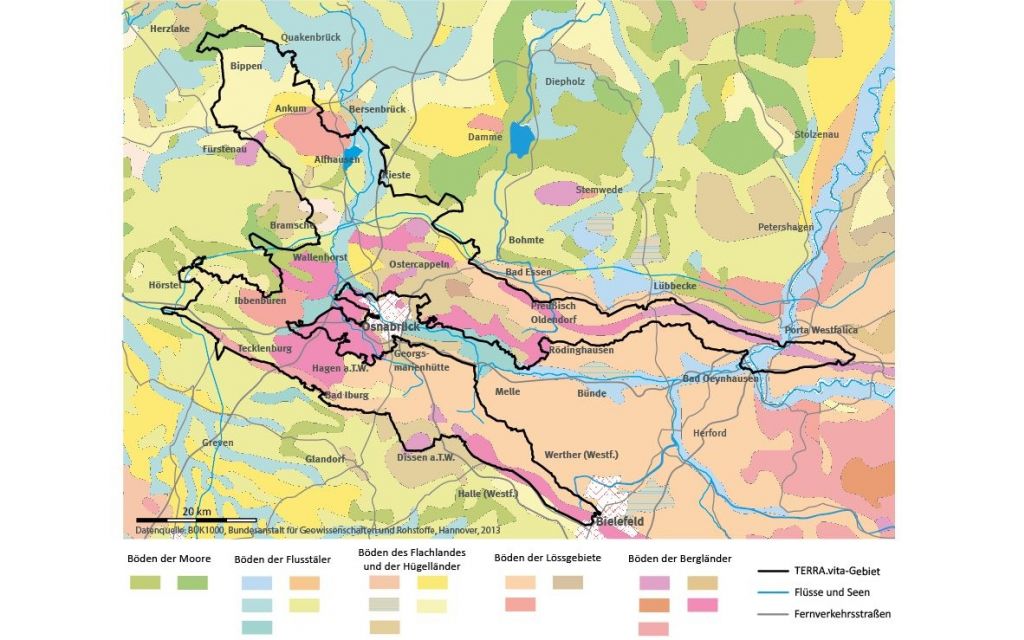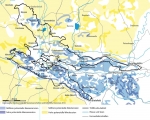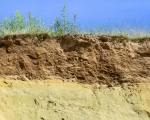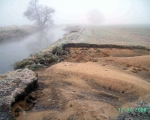Soil and soil erosion
Soil fulfills many vital functions for us humans.
We use soil not only to produce biologically based raw materials through agriculture and forestry or as ground to settle on. It assumes many other important tasks for us as well.
Did you know that soil filters pollutants from seeping rainwater (like a coffee filter!) and that microorganisms in the soil can break them down? Did you know that soil stores our water and slows down global warming by absorbing the greenhouse gas carbon dioxide? And most importantly - it provides the basis for a variety of habitats for plants, animals, fungi, and microorganisms.
Along with water and air, soil is one of the foundations of our existence. Protecting the soil and maintaining its fertility have always been prerequisites for successful agriculture and stable societies.
What is soil actually?
There is no one single soil!
As a result of differences in the underlying rock and landscape relief, geogenic relocation processes, and influences from climate and organisms, a wide variety of soil types are formed over long periods of time. As a prerequisite for the formation of soils, a starting material is necessary. These are usually rock layers close to the surface – be it solid rock (for example, sandstone) or loose sediment (for example, sand).
Lucky coincidences in the history of the Earth and life resulted in evidence of the past 300 million years being almost continuously preserved in the subsurface of TERRA.vita. This high level of geodiversity made it possible for a large number of different soils to develop in the Nature and Geopark area.
For soil to form, soil-forming processes must transform the parent rock material. Weathering breaks it down biologically, physically, and chemically into smaller and smaller rock particles. This occurs through rainwater, wind, the mechanical expanding and disintegrating forces of plant roots and frost, and through the decomposition of dead plant and animal material by other animals and microorganisms.
Primarily by activating the soil with microorganisms, bacteria, and fungi, organic substances (humus) and pore spaces are formed, which make the soil fertile. This is how an initial soil zone (soil horizon) gradually develops. Through a variety of processes, soil formation continues into deeper zones, so that deep, fine-grained, heavily weathered, washed-out soils emerge from initially shallow, stony, slightly weathered, mineral-rich soils. It takes about 100 to 300 years to form a one-centimeter-thick (less than half an inch) layer of soil.
Atlas of Soils in the TERRA.vita Nature and Geopark
Soil scientists at the Osnabrück University of Applied Sciences have presented profiles of the types and properties of soils found in the Nature and Geopark in the “Soil Atlas”. The Soil Atlas presents, in an easily understandable way, information about the distribution, properties, use, and special features of the soil types here, as well as the dangers to them from use.
Further information on the Soil Atlas can be found HERE.
Soil erosion – a geohazard
However, due to the effects of the global climate catastrophe, the soils in the area of the UNESCO Geopark TERRA.vita are increasingly subject to another geohazard – soil erosion. Soil erosion describes the removal of surface soil material by water or wind.
It becomes particularly important for our society when the fertile soil of our agricultural land is damaged by large-scale soil removal. However, not every cultivated area is affected by this geohazard and, above all, not to the same extent.
In our region, areas that are located on steep slopes and those laid out on loess are particularly exposed to increased risks of erosion. If areas are severely parched and only sparsely covered by vegetation, soil particles can be set in motion by strong winds and lead to dust storms.
Climate change increases the risk of soil erosion due to more frequent and longer periods of heavy rain events and droughts. In our region, protective measures are being applied to these endangered areas.
For further information on soil, soil erosion and soil protection, please refer to our soil erosion brochure.
TERRA.park Fascination of Soil
The two-hectare (five-acre) TERRA.park Fascination of Soil (Am Schölerberg 1, 49082 Osnabrück, near the county government building and just south of the zoo), provides information about soil, land use, and contaminated sites, as well as about the rocks of this region and Earth’s geological history.
The soil park and the soil pavilion are open to the public free of charge from 9 a.m. to 7 p.m. during the summer season (April through September), and from 10 a.m. to 6 p.m. during the winter season (October through March). The TERRA.park is particularly suitable as an extracurricular learning location.
Interested teachers and educators should contact info@geopark-terravita.de. Further information can be found HERE.






